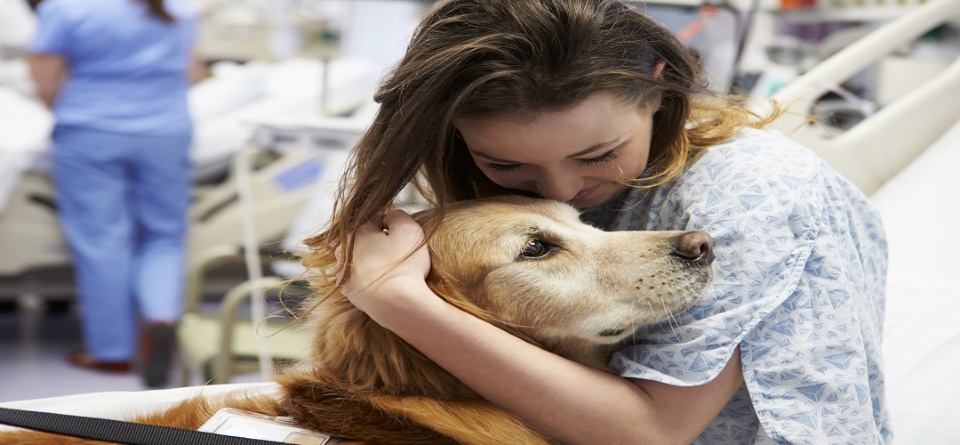For most people, the care,
love and affection that animals can bring to one’s life is a fact commonly
understood. The social benefits of interacting with pets are not only
universally recognized, they are also scientifically proven.
Animal-assisted therapy is a
fairly new form of treatment that aims to involve different types of animals in
the therapeutic process of people of all age groups, dealing with a variety of
issues. This type of therapeutic intervention can help with social, emotional
and cognitive limitations, as well as help patients physically and psychologically.
Even more recent than
animal-assisted therapy itself, is its success with at-risk youth – teenagers
with lower than average chances of successfully transitioning into adulthood
and the responsibilities that come with it. Teenagers that benefit from this
type of therapy include those that suffer from depression, psychotic episodes,
eating disorders and anxiety. Developing communication skills, increasing self-esteem
and improving overall social skills are the main desired outcomes of pet
therapy for at-risk youth.
“They learn to properly
socialize and conduct themselves in front of animals and people,” says Gaby
Dufresne-Cyr of The Dogue Shop, a science-based animal behaviour school in
Montreal. “The program gets very intimate, very fast. People bond with people,
and teens bond with dogs.”
Dufresne-Cyr trains animals,
pet owners, dog trainers, animal behaviour consultants and animal-assisted
therapists. The Dogue Shop offers two types of pet therapy programs (also
commonly known as zootherapy) – one that uses rats as pet partners, while the
other makes use of dogs. The Dogue Shop partners with alternative high schools
that teach at-risk youth and recently launched a ten-week program at EMSB’s
Perspectives High School II.
“I implemented the full
program at Perspectives II and also Focus High School,” says Dufresne-Cyr. “I
oversee the exercises, but the teens work directly with my students and their
dogs – sometimes they are also teens from another school partaking in an
internship at my establishment. Teens helping teens is the best.”
Pet therapy for at-risk youth
is mostly done in groups so that the teenagers can not only interact with the
animals, but also learn to interact with one another because, essentially, that
is the ultimate goal. Teenagers easily connect with dogs because they are
affectionate straightaway and because dogs are very interested in people, and
vice versa; however dogs are not the only animals that at-risk youth feel
connected to. According to
Frédérique Hébert-Villeneuve, animal-assisted therapy supervisor at the Douglas
Mental Health Institute, teenagers surprisingly connect with rats and ferrets
even more so than dogs.
“[Rats] are different, so the
teenagers like them and it’s really cool to see them together,” says
Hébert-Villeneuve. “Rats are very intelligent animals and they are stereotyped–
people don’t like rats– so these teens see a projection of themselves in the rats.”
The Douglas’ animal-assisted
therapy program is also home to cats, parrots, guinea pigs and a rabbit that
aim to help all their patients–children, teenagers, adults and elderly living
with mental illness.
“We have to feed [the animals],
give them water, clean their cages, take the dogs for walks and most of the
teens here don’t even know that they are capable of doing these things,” says
Hébert-Villeneuve. “By making them try things, they can develop different
skills – even to open a bird cage can be a challenge in itself.”
At the end of the programs The
Dogue Shop launched in certain Montreal schools, the students will put on a
show in front of the entire school, and this speaks directly to the goals of
the program. The mere fact that these students will have the confidence to go
up in front of their peers after ten weeks of therapy is an important measure
of success of the program.
Dufresne-Cyr believes ten
weeks to be an ideal amount of time for teenagers to reach some of their objectives
and to be able to create a bond with the dogs and with each other.
Hébert-Villeneuve acknowledges fluctuations in success time—from really short
to really long—depending on the individual, the mental illness and also the
medication and additional forms of therapy the patient is involved with.
Essentially, animal-assisted
therapy—and all therapy for that matter—works differently for everyone,
benefits each individual on a different level and yields unique results from
one person to another. Yet, the overall final outcome is very much the same in
all cases; a goal was set, pursued professionally and therapeutically and
ultimately reached.
“We have to see the
animal-assisted therapy program as one approach; it is a different way to
work,” says Hébert-Villeneuve. “My profession is special care counselling, so I
was trained in this domain, but I chose to work with animals so we can observe
all teenagers in a different light.”
This observation and
understanding of at-risk youth is made possible by the environment created
within pet therapy facilities. “Animal-assisted therapy is a form of
relationship building based on the absence of judgement,” says
Dufresne-Cyr. Therapy involving animals has this ‘judgement-free’ advantage
over any other type of therapy simply because animals do not judge. That fact
alone is imperative to the success of animal-assisted therapy. “When you have a
mental illness you always feel like you are being judged because you are even
judging yourself,” says Hébert-Villeneuve.
Although the Douglas pioneered
this field of study in Quebec over 30 years ago and remains the leading
integrated zootherapy program in the province, other facilities have begun to
follow suit. The Laval Veterinary Center has had its own service dog department
since 2011, known as the Asista Foundation, which provides service dogs for
those suffering from PTSD, Autism and Mental Support Disabilities. “We supply
service dogs not for the people who cannot see, but for those who have seen too
much,” says John Agionicolaitis, the Chair of this department.
There are several federal institutions,
most notably Can Praxis, which provides horse therapy for veterans suffering
from PTSD, that are looking to shed light on the phenomenon of pet therapy as a
whole despite research on this matter being quite slow and difficult due to its
subjective nature.
Nevertheless, there are also
many institutes, such as the Douglas, who do not cease in their efforts to
expand their knowledge of animal-assisted therapy specifically aimed at at-risk
youth and are fighting the good fight for more research, so that teenagers can
learn to fight for themselves.

 In The Latest Issue:Latest Issue:
In The Latest Issue:Latest Issue:
- Celebrating Community an...
- Celebrating the Unsung H...
- Understanding Newborn St...
Articles
Calendar
Virtual- ANNUAL TEACHER APPRECIATION CONTEST
- APPUI LAVAL
- ARTS & CULTURE
- CAMPS
- CAR GUIDE
- CCIL
- CENTENNIAL ACADEMY
- CHARITY FUNDRAISING
- CITYTV
- COSMODÔME
- COMMUNITY CONNECTIONS
- COVER STORY
- DINA DIMITRATOS
- ÉCOLE SUPÉRIEURE DE BALLET DU QUÉBEC
- EDITORIALS
- ÉDUCALOI
- EDUCATION
- EMPLOYMENT & ENTREPRENEURSHIP
- FÊTE DE LA FAMILLE
- FÊTE DU QUARTIER SAINT-BRUNO
- FAMILIES
- FESTIVAL LAVAL LAUGHS
- FÊTE DE QUARTIER VAL-DES-BRISES
- FINANCES
- GLI CUMBARE
- GROUPE RENO-EXPERT
- HEALTH & WELL-BEING
- 30 MINUTE HIT
- ANXIETY
- CHILDREN`S HEALTH & WELLNESS
- CLOSE AID
- DENTAL WELLNESS
- EXTREME EVOLUTION SPORTS CENTRE
- FONDATION CITÉ DE LA SANTÉ
- GENERAL
- HEARING HEALTH
- MESSAGES FROM THE HEALTH AGENCY OF CANADA
- MENTAL HEALTH
- SEXUALITY
- SOCIAL INTEGRATION
- SPECIAL NEEDS
- TEENS
- THE NUTRITION CORNER
- THE NUTRITION CORNER - RECIPES
- VACATION DESTINATION
- WOMEN'S FITNESS
- WOMEN'S HEALTH
- HILTON MONTREAL/LAVAL
- HOME & GARDEN
- INTERNATIONAL WOMEN'S DAY
- JAGUAR LAVAL
- LAVAL À VÉLO
- LAVAL FAMILIES TV SHOW
- LAVAL FAMILIES MAGAZINE CARES
- LAVAL URBAN IN NATURE
- LE PARCOURS DES HÉROS
- LES PETITS GOURMETS DANS MA COUR
- LEON'S FURNITURE
- LEONARDO DA VINCI CENTRE
- LFM PREMIERES
- LIFE BALANCE
- M.P. PROFILE
- MISS EDGAR'S AND MISS CRAMP'S SCHOOL
- MISSING CHILDREN'S NETWORK
- NETFOLIE
- NORTH STAR ACADEMY LAVAL
- OUTFRONT MEDIA
- PASSION SOCCER
- PARC DE LA RIVIÈRE-DES-MILLE-ÎLES
- PÂTISSERIE ST-MARTIN
- PIZZERIA LÌOLÀ
- PLACE BELL
- PORTRAITS OF YOUR MNA'S
- ROCKET DE LAVAL
- SACRED HEART SCHOOL
- SCOTIA BANK
- SHERATON LAVAL HOTEL
- SOCIÉTÉ ALZHEIMER LAVAL
- STATION 55
- STL
- SUBARU DE LAVAL
- TECHNOLOGY
- TEDXLAVAL
- TODAY`S LAURENTIANS AND LANAUDIÈRE
- TODAY`S LAVAL
- WARNER MUSIC
- THIS ISSUE
- MOST RECENT
Magazine
Pets and Teens: Together for Mental Health
Articles ~e 105,7 Rythme FM 4 chemins Annual Teacher Appreciation Contest Appui Laval Arts & Culture Ballet Eddy Toussaint Camps THIS ISSUE MORE...
CONTESTS Enter our contests
CONTESTS Enter our contests
CALENDAR
Events & Activities
COMMUNITY Posts Events
PUBLICATIONS Our Magazine Family Resource Directory
LFM BUSINESS NETWORK Learn more
COUPONS Click to save!
COMMUNITY Posts Events
PUBLICATIONS Our Magazine Family Resource Directory
LFM BUSINESS NETWORK Learn more
COUPONS Click to save!
SUBSCRIPTIONS
Subscribe to the magazine
Un-Subscribe
E-NEWSLETTER Subscribe to our E-newsletter Un-Subscribe
WRITE FOR US Guidelines & Submissions
POLLS Vote today!
E-NEWSLETTER Subscribe to our E-newsletter Un-Subscribe
WRITE FOR US Guidelines & Submissions
POLLS Vote today!
ADVERTISERS
How to & Media guide
Pay your LFM invoice
SUGGESTIONS Reader's Survey Suggest a Listing
LFM About Us Our Mission Giving Back Contact Us
SUGGESTIONS Reader's Survey Suggest a Listing
LFM About Us Our Mission Giving Back Contact Us
 PICK-UP LOCATIONS
Get a copy of LFM!
PICK-UP LOCATIONS
Get a copy of LFM!
TERMS & CONDITIONS Privacy | Terms
ISSN (ONLINE) 2291-1677
ISSN (PRINT) 2291-1677
Website by ZENxDESIGN




 BY:
BY: 


Tweet
Share